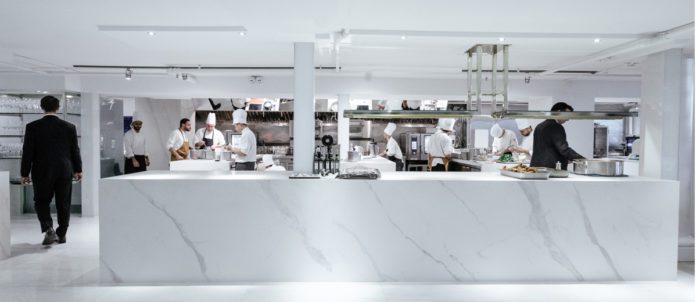From rising equipment costs to strategizing for higher-volume takeout service, the new normal of kitchen design comes with a host of new considerations for operators. As the foodservice industry continues to re-bound from the impacts of the pandemic, planning early for new build or kitchen re-design has become more essential than ever in order to keep costs and timelines under control.
“I could go on and on about permitting,” says Jude Kamal, registered interior designer at Toronto-based Sansa Interiors. When approaching a new kitchen design, she recommends operators start thinking about the necessary permits as soon as possible to mitigate delays caused by the lingering backlog in applications.
Jenny Companion, vice-president of the Fifteen Group in Toronto, says the pandemic has also created lasting supply-chain issues. “We haven’t seen the end of the logistics challenges,” she says. “At this point, we’re telling most of our clients, if they’re looking to open, they should be ordering their equipment 12 to 16 weeks in advance at minimum.”
Dimos Argiropulos, project director at Toronto-based Nella Cutlery & Food Equipment, says he’s also seen recent kitchen renovations face challenges caused by supply shortages. “We’ve seen supply-chain issues across the board, from smallwares to equipment to food,” he says. “We find that people are piecemealing and building with what’s available right now and everything that we do get is coming with a higher cost.”
Companion agrees that the growing cost of equipment is also an important consideration for operators planning a re-design or new build. “The frequency of price increases has gone up,” she says. “Historically, we would see price increases with equipment go up once or twice a year. Now, it’s going up quarterly and, in some cases, monthly.”
Companion says operators looking to minimize costs when setting up their kitchens need to take a strategic approach. For example, she advises that those searching for a new restaurant space prioritize units that already have an existing kitchen or a venting system. “Putting in venting can be a challenge,” she says, “both in getting approval from the landlord and it’s also a really costly item.”
With shortages and increasing costs in mind, Companion also recommends operators consider the pros and cons of purchasing versus leasing kitchen equipment. “Things like dishwashers and glasswashers, we often suggest you weigh out the opportunity to lease them from suppliers that also provide regular maintenance and service,” she explains. “It’s a great way to save on the capital expense upfront and then also get ongoing support throughout the year. That way, on a Friday night, if your dishwasher goes down, you’re not searching for a plumber and having to find the cost to pay for it.”
Nadia Di Donato, vice-president and creative director at Liberty Entertainment Group, advises operators to think long-term when budgeting for their kitchen design. “[For] Many restaurateurs coming out of the gate, it’s all budget and they will look at getting used or re-furbished equipment but oftentimes, you’ll find you don’t get a very long lifespan out of it and you end up spending double,” she says. “When you cut corners in equipment, in the long run, it really does end up costing you more money.”
Di Donato suggests restaurateurs instead aim to save on operational costs by designing a smart, streamlined kitchen. “The cost efficiency comes in a really well-organized kitchen,” she says. “It’s important to lay out all of your equipment so there isn’t any loss of time or paths crossing when it comes to the dishes being plated or prepared.”
With many operators now putting a greater emphasis on off-premise dining or running multiple concepts out of a single kitchen, design is becoming focused on how to do more with less space. “It’s about finding the right pieces of equipment that can align and allow you to execute different menu styles and food styles,” explains Companion.
Kamal suggests that, for this reason, it’s a good idea for operators to approach a kitchen design with a plan for the menu (or menus) they plan to execute in the space. “The menu has to overlap in terms of preparation,” she says. “If you’re planning on getting fryers, don’t just sell French fries but get other items that need frying as well.”
Choosing versatile equipment this way is key to saving on both space and costs. “There are a lot of bells and whistles out there that ideally, sure, you’d like to have, but a kitchen can function without half of them,” adds Di Donato.
According to Kamal, efficiency is becoming a top priority in kitchens as the industry emerges from the pandemic. “I feel like there’s going to be a lot of new restaurants coming up with a really different approach — and that approach is going to be focused on being fast and efficient,” she says.
Di Donato notes that the new emphasis on off-premise dining, for example, means designing kitchens with quick takeout and delivery service in mind. “We always try to have additional under-counter cooling for things that need to be accessed immediately,” she says as an example. “Then if you’re giving the client milk or sauces or anything like that while they’re paying, it’s right under you, instead of walking back into a fridge.”
The pandemic may also have enduring impacts on kitchen-design aesthetics. Di Donato says the open-kitchen trend is here to stay, with many diners now wanting a deeper insight into the health-and-safety practices of restaurants.
“It’s a matter of people wanting to see how their food is prepared from an aesthetic point of view, but also from a health point of view,” she says. “They want to make sure kitchens are clean, and open kitchens do default to having to keep your kitchen at a much higher level of cleanliness, merely because it’s visible.”
With diners able to see both the front- and back-of-house, Di Donato says equipment that is both beautiful, as well as practical, will shape the future of kitchen design. “You don’t just create kitchens as a separate entity from the restaurant. It’s really important in the function and design to create the kitchen so it has synergy with the front of house,” she says. “When it comes to some of the conventional items that you require in a kitchen, there’s nothing to say that they can’t be aesthetically pleasing as well.”
By Jessica Huras




![Redberry Restaurants Becomes Canada’s Area Director for Jersey Mike’s Subs Expansion Redberry Jersey Mike’s Subs - Paul Pascal (left), director of Operations, and Stephen Scarrow (right), senior Marketing manager]](https://www.foodserviceandhospitality.com/wp-content/uploads/2024/04/Redberry-Appointments-218x150.jpg)













